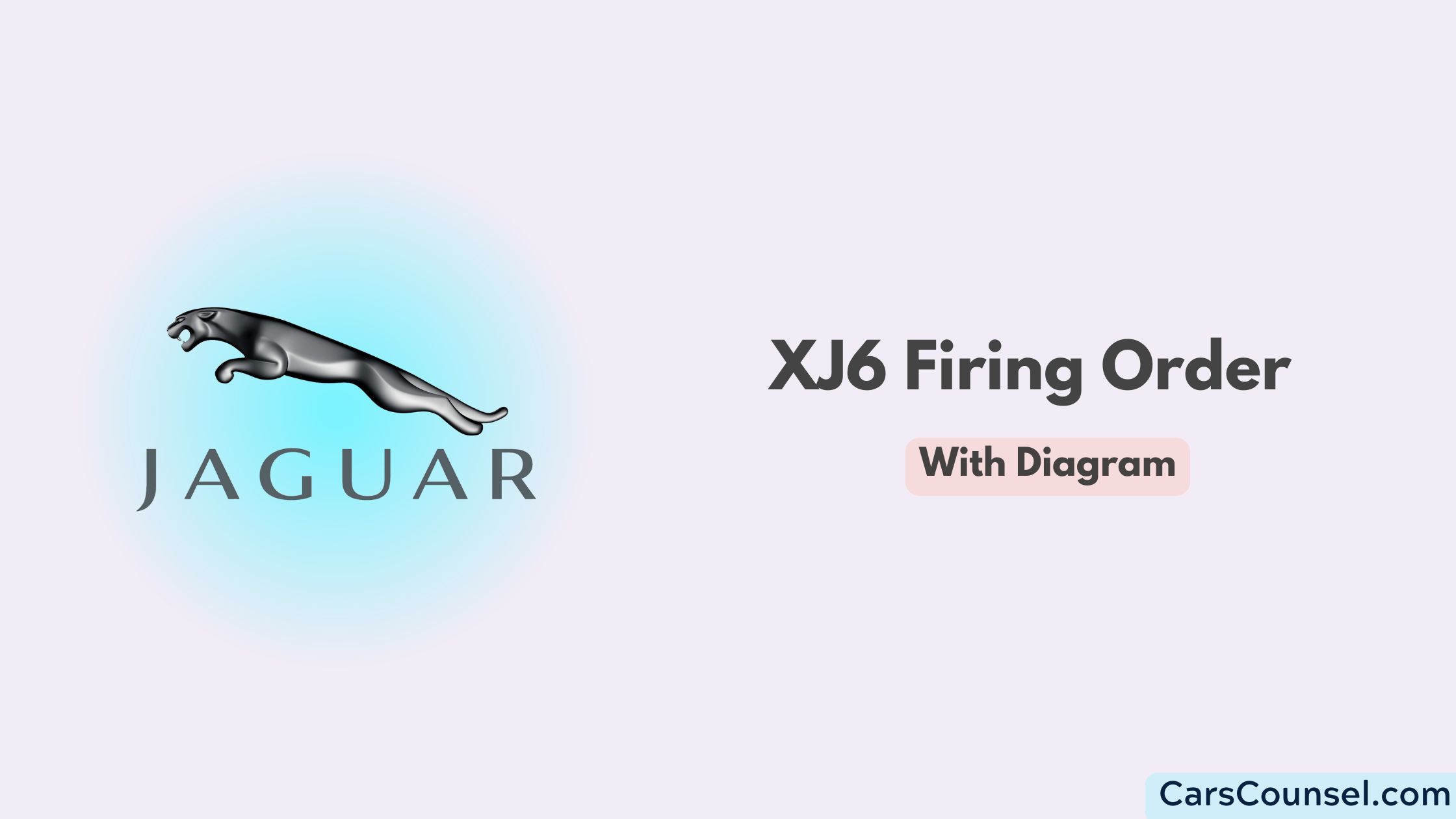The Jaguar XJ6, a luxury sedan known for its refinement and performance, is powered by the iconic Jaguar XK inline-six engine. This engine, a hallmark of Jaguar engineering, has been central to the XJ6’s reputation for smooth operation and impressive power.
At the heart of this engine’s performance is its firing order, the sequence in which its cylinders fire to produce efficient and balanced power.
This guide explores the firing order of the Jaguar XJ6, why it matters, and how to maintain and troubleshoot it. Whether you’re an XJ6 owner, a classic car enthusiast, or a mechanic, this article provides the essential details to help you keep the engine running smoothly.

Quick Navigation
The Jaguar XJ6 Firing Order
The firing order for the Jaguar XJ6 engine is: 1-5-3-6-2-4

How the Firing Order Works
- Cylinder 1 Fires First: Located at the front of the engine, it starts the combustion cycle.
- Cylinder 5 Fires Second: Ignition moves to the fifth cylinder, skipping cylinders 2, 3, and 4.
- Cylinder 3 Fires Third: The middle cylinder in the sequence ignites next.
- Cylinder 6 Fires Fourth: The rearmost cylinder fires.
- Cylinder 2 Fires Fifth: Combustion shifts to the second cylinder.
- Cylinder 4 Fires Last: The fourth cylinder completes the cycle before restarting with Cylinder 1.
This alternating sequence balances the engine’s operation and ensures smooth power delivery.
Why Jaguar Uses the 1-5-3-6-2-4 Firing Order
The 1-5-3-6-2-4 firing order is ideal for the inline-six engine configuration due to the following reasons:
- Natural Balance: Inline-six engines are inherently balanced, and this firing order further enhances smoothness by distributing power strokes evenly.
- Crankshaft Design: Matches the crankshaft’s throw pattern, minimizing mechanical stress.
- Vibration Reduction: Properly spaced ignition events reduce vibrations and ensure stable operation.
- Performance Efficiency: Ensures consistent torque output and optimal combustion.
What Is a Firing Order?
The firing order refers to the sequence in which an engine’s spark plugs ignite the air-fuel mixture in each cylinder. This controlled combustion generates power that drives the pistons and rotates the crankshaft. In the inline-six engine of the XJ6, the firing order is carefully designed to balance operation and maximize efficiency.
Why the Firing Order Matters
- Smooth Operation: Ensures even power delivery and minimizes vibrations.
- Efficiency: Proper sequencing enhances fuel combustion and reduces emissions.
- Durability: Distributes stress evenly across the crankshaft and internal components.
- Performance: Provides consistent torque for smooth acceleration and drivability.
Overview of the Jaguar XJ6 Engine
The Jaguar XJ6 is powered by the Jaguar XK engine, a 4.2-liter inline-six configuration (in most models) known for its longevity and advanced engineering. This engine, first introduced in 1949 and refined over decades, became a symbol of Jaguar’s engineering prowess.
Key Features of the Jaguar XK Engine
- Inline-Six Layout: Six cylinders arranged in a straight line.
- DOHC (Dual Overhead Camshaft): Improves airflow and valve control.
- Carbureted or Fuel-Injected: Depending on the model year, the engine uses either carburetors or electronic fuel injection (EFI).
- Cylinder Numbering:
- Cylinders are numbered sequentially from front to rear:
- Cylinder 1 is at the front (closest to the radiator).
- Cylinder 6 is at the rear (closest to the firewall).
- Cylinders are numbered sequentially from front to rear:
Identifying the Firing Order
Understanding the cylinder layout and ignition system is crucial for verifying or adjusting the firing order.
Cylinder Numbering
The cylinders are numbered from front to rear:
- Cylinder 1: Closest to the radiator.
- Cylinder 6: Closest to the firewall.
Distributor Orientation
The XJ6 engine uses a distributor-based ignition system. The distributor cap directs spark to the correct cylinder in alignment with the firing order. The rotor inside the distributor rotates clockwise, sending electrical signals to the spark plugs based on the 1-5-3-6-2-4 sequence.
Symptoms of an Incorrect Firing Order
An incorrect firing order can disrupt the engine’s performance and lead to noticeable problems. Identifying these symptoms early can help you resolve issues quickly.
Common Symptoms
- Engine Misfires: Cylinders fire out of sequence, leading to uneven power delivery.
- Rough Idling: The engine vibrates excessively or feels unstable when idling.
- Power Loss: Reduced acceleration and sluggish performance.
- Backfiring: Combustion occurs in the intake or exhaust system due to improper timing.
- Increased Fuel Consumption: Inefficient combustion results in higher fuel usage and emissions.
Diagnosing and Fixing Firing Order Problems
If you suspect firing order issues in your Jaguar XJ6, follow these steps to diagnose and resolve them:
Diagnostic Steps
- Inspect Spark Plug Wires: Verify that each wire is connected to the correct cylinder based on the 1-5-3-6-2-4 firing order.
- Check the Distributor Cap: Ensure the rotor aligns correctly with the terminals on the distributor cap.
- Use a Timing Light: Confirm that the ignition timing matches the manufacturer’s specifications.
- Perform a Compression Test: Ensure all cylinders have adequate compression to support proper firing.
Fixing Common Issues
- Reconnect Spark Plug Wires: Ensure each wire is routed correctly and securely attached to its corresponding spark plug.
- Replace Faulty Components: Install new spark plugs, ignition wires, or distributor caps if they show signs of wear or damage.
- Adjust Timing: Use a timing light to align the distributor and ensure it matches the firing order.
- Inspect the Timing Chain: Check for slack or misalignment that could affect ignition timing.
Preventative Maintenance for Firing Order Reliability
Maintaining the correct firing order is essential for the long-term performance of your XJ6 engine. Follow these preventative tips to avoid firing order issues:
Regular Inspections
- Check spark plugs, ignition wires, and the distributor for wear or damage.
- Inspect the timing chain and related components for proper alignment and tension.
Replace Components as Needed
- Replace spark plugs and ignition wires at recommended intervals.
- Use high-quality OEM parts to ensure compatibility and reliability.
Monitor Engine Performance
- Pay attention to changes in engine behavior, such as rough idling or reduced power.
- Use diagnostic tools to identify and address potential issues early.
FAQs About the XJ6 Firing Order
Can I Change the Firing Order?
No, the firing order is determined by the engine’s design and crankshaft configuration. Altering it would require extensive mechanical modifications.
What Happens If the Firing Order Is Incorrect?
An incorrect firing order can cause misfires, power loss, backfiring, and potential damage to engine components.
How Can I Verify the Firing Order?
Refer to the service manual, inspect spark plug wire connections, and use timing tools to confirm the ignition sequence.
Is the Firing Order the Same for All Inline-Six Engines?
While many inline-six engines share the 1-5-3-6-2-4 firing order, variations may exist depending on the manufacturer and engine design.
Engines with Similar Firing Orders
- 2012 Chevy Silverado 5.3 Firing Order
- 2011 Chevy 5.3 Firing Order
- Chevy 350 Firing Order
- ZZ502 Firing Order
- ZZ4 Firing Order
Conclusion
The 1-5-3-6-2-4 firing order is a fundamental component of the Jaguar XJ6’s inline-six engine, ensuring smooth operation, balanced power delivery, and efficient combustion. Understanding and maintaining this sequence is essential for keeping your XJ6 running reliably and performing at its best.
By following proper maintenance practices, addressing issues promptly, and using high-quality parts, you can enjoy the refined performance of the Jaguar XK engine for years to come. Whether you’re restoring a classic or maintaining your daily driver, mastering the firing order is a key step in caring for this iconic British powerplant.

